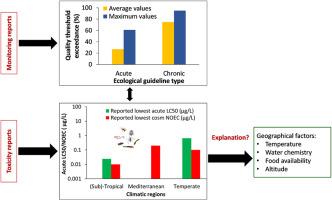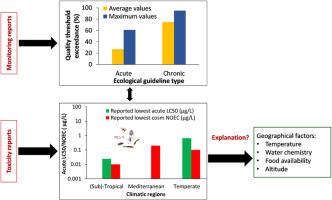吡虫啉对水生物种和生态系统毒性的气候带相关变化综述
IF 7.3
2区 环境科学与生态学
Q1 ENVIRONMENTAL SCIENCES
引用次数: 0
摘要
广泛使用的杀虫剂吡虫啉(IMI)是世界范围内水污染的主要问题。在这篇综述性研究中,总结了水体中IMI的监测值、毒性结果和可能与地理相关的毒性调节剂,以突出研究空白,这些空白阻碍了对(亚)热带和温带水生生物之间观察到的IMI毒性变化的机制理解。IMI的平均监测值为0.00019 ~ 59 μg/L。在这些平均IMI值中,分别有27%和75%超过了淡水无脊椎动物的急性和慢性基准。温带节肢动物和亚热带节肢动物的急性LC50中值分别为109 μg/L和68 μg/L。据报道,温带、地中海、亚热带和热带地区的中尺度NOEC标称值分别为0.5 ~ 7.5 μg/L、0.1 ~ 1 μg/L、0.03 ~ 0.3 μg/L和0.01 ~ 0.1 μg/L。这些IMI对水生节肢动物的毒性阈值在区域之间存在显著差异,与地中海-温带生物相比,(亚)热带生物对IMI更敏感。这些敏感性的差异可能是由地理相关因素造成的,如温度、食物供应和海拔的差异,导致生物体内化学物质的毒性动力学和毒性动力学的变化,但也会导致测试生物的生活史参数的变化。我们的综述显示,随着温度的升高,IMI对水生节肢动物的毒性增加,这在一定程度上解释了观察到的毒性差异。本文章由计算机程序翻译,如有差异,请以英文原文为准。


A review of climatic zone-related variations in toxicity of imidacloprid towards aquatic species and ecosystems
The widely used insecticide imidacloprid (IMI) is a major concern of water pollution worldwide. In this review study, monitoring values of IMI in water bodies, toxicity results, and possible geographical-related toxicity modifiers are summarized to highlight research gaps that hamper a mechanistic understanding of the variation in IMI toxicity observed between (sub)-tropical and temperate aquatic organisms. The average monitoring values of IMI ranged from 0.00019 to 59 μg/L. 27 % and 75 % of these average IMI values exceeded the freshwater invertebrates-based acute and chronic benchmarks, respectively. The median acute LC50 values of 109 μg/L and 68 μg/L are reported for temperate and (sub)-tropical arthropods, respectively. The reported ranges in nominal NOEC values for mesocosm studies are 0.5–7.5 μg/L, <0.1–1 μg/L, 0.03–0.3 μg/L and <0.01–0.1 μg/L for temperate, Mediterranean, sub-tropical and tropical regions, respectively. These toxicity threshold values of IMI to aquatic arthropods were significantly different between the regions, where (sub)-tropical organisms are more sensitive to IMI as compared to their Mediterranean-temperate counterparts. These differences in sensitivity can result from geographically related factors such as differences in temperature, food availability, and altitude, leading to changes in the toxicokinetics and toxicodynamics of the chemical in the organisms, but also to changes in life-history parameters of the test organisms. Our review shows an increase in IMI toxicity to aquatic arthropods with rising temperatures, which partly explains the observed differences in toxicity.
求助全文
通过发布文献求助,成功后即可免费获取论文全文。
去求助
来源期刊

Environmental Pollution
环境科学-环境科学
CiteScore
16.00
自引率
6.70%
发文量
2082
审稿时长
2.9 months
期刊介绍:
Environmental Pollution is an international peer-reviewed journal that publishes high-quality research papers and review articles covering all aspects of environmental pollution and its impacts on ecosystems and human health.
Subject areas include, but are not limited to:
• Sources and occurrences of pollutants that are clearly defined and measured in environmental compartments, food and food-related items, and human bodies;
• Interlinks between contaminant exposure and biological, ecological, and human health effects, including those of climate change;
• Contaminants of emerging concerns (including but not limited to antibiotic resistant microorganisms or genes, microplastics/nanoplastics, electronic wastes, light, and noise) and/or their biological, ecological, or human health effects;
• Laboratory and field studies on the remediation/mitigation of environmental pollution via new techniques and with clear links to biological, ecological, or human health effects;
• Modeling of pollution processes, patterns, or trends that is of clear environmental and/or human health interest;
• New techniques that measure and examine environmental occurrences, transport, behavior, and effects of pollutants within the environment or the laboratory, provided that they can be clearly used to address problems within regional or global environmental compartments.
 求助内容:
求助内容: 应助结果提醒方式:
应助结果提醒方式:


